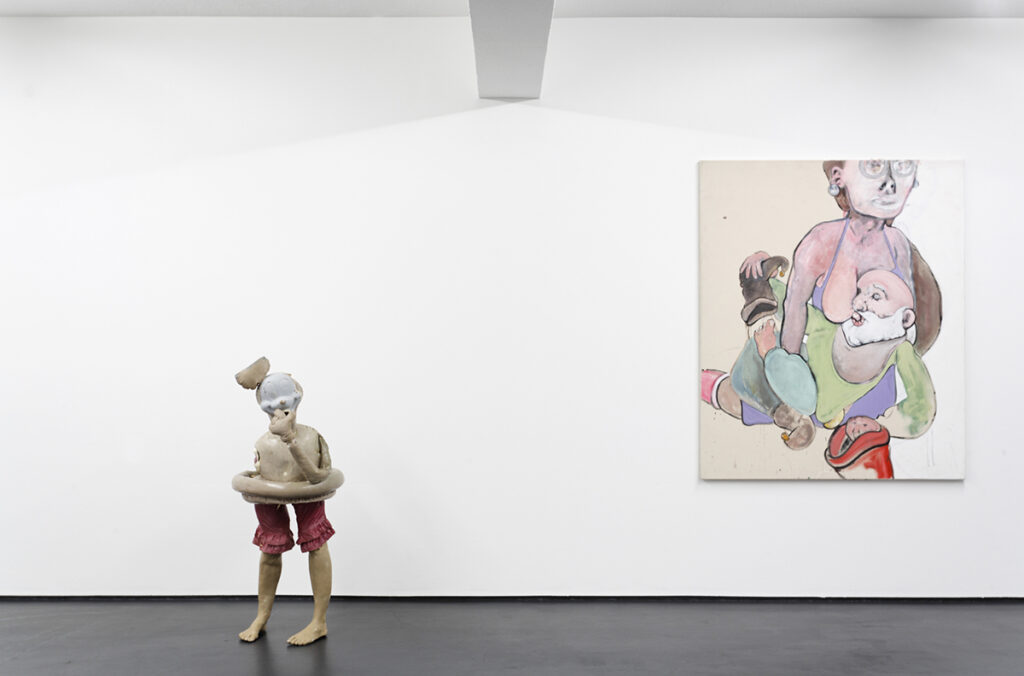Bas de Wit
Breit für Leid
September 2 – October 21, 2006

A shipwrecked sailor who tore off one of his legs in order to create a signal; an elderly lady, caressing her cactus; a ghost who is darting out of a spraycan; dwarfs which push a wheelbarrow loaded with a monstrous erected penis; Donald Duck, whose beak is formed by intestines and a Minnie Mouse who is blind on one of her eyes – from these and other creatures the Dutch artist Bas de Wit (*1977) forms his visual repertoire of his paintings and sculptures.
At first sight, we believe to recognize personal from comic strips, fairy tales and narrations read by us in our youth. However, what irritates are the deformations, or better: the mean deconstructions of the associations we have when we see the figures. Because it is not Minnie Mouse with a friendly wink in her eye, but a Minnie Mouse monster, that is not really cute. And it is not Defoe’s hero Robinson Crusoe, who is – full of hope – looking forward to his future recovery. These figures subvert our expectations, nourished by clichés, as the exotic beauties of the South Pacific do who have been cloned by de Wit from Gauguin´s repertoire without getting too close to the original by, for instance, letting the nurturing mother smoke a cigarette; therefore, we do not see the longed-for “primitive”, beautiful and pure women. Our selective vision of the authenticity of the wild ones and its eurocentric background are, again, subverted by de Wit. These kinds of ironies are the potential of his works.
The artist is not aiming to represent with a more or less high degree of similarity figures or situations we know, but he tries to enlarge the spectrum of possible meanings. Bas de Wit does not pin down his works and us to only one meaning and he is thereby withdrawing the one valid meaning of a narration, the redeeming moral. Structural openness – contentwise as well as formal – can be said to be one characteristic feature of all his works. Thereby, de Wit is stimulating thinking processes, which, however, in the end he lets run dry. He frustrates us because our first associations are not true. By working like this, contents loose, on the one side, their significance and, on the other side, the possibilities of creating remain fascinating, as we can experience by following the processes of the artist’s creation:
Because Bas de Wit´s works gain their potential to worry their viewers also from the different ways of their production. Often, the traditional finito is confronted with the non-finito: While some areas of the paintings perfectly simulate reality – whatever that is in the world of fairy tale- and phantasy figures – and therefore seem to have clear meanings, others remain unfinished. And in particular the sculptures seem to be carelessly handcrafted, created in the chaos of the sloppy studio. While these parts of the works remain open as far as regards their content, on a formal level they let the viewer discover the processes of the production, which is another form of transparency: Bas de Wit is creating his sculptures with poisonous foams by taking masks from friends or himself. He lets shoot up, drip, and stick the polyurethanes.
In his paintings the acrylic paint runs over the canvas, seemingly without control, over preparatory drawings in charcoal, which often serve only as a kick- off point for surreal developments with their own logic and energy and thereby are neglected in the end. The first ideas about a work are only loosely connected to the final results. Finally, the openness of the works can be seen in the fact that often large parts of the paintings remain unpainted even though they remain important parts of the precisely controlled image and the picture plane.
The title of our exhibition, Breit für Leid, stands not only for the condition of being stoned which threatenes the artist when he does not use the necessary protective mask during the production of his sculptures, but – in German – it alludes also to the readiness to suffer, even though this happens rather in the image than anywhere else. Additional possible meanings of the title in German, which can barely be translated into other languages, do – again – rather dissolve any clarity then giving a clear meaning to the viewers. The only thing that becomes clear is that even the title chosen by Bas de Wit is a proof for his endeavor to structural openness in order to play a game of signs and meanings.